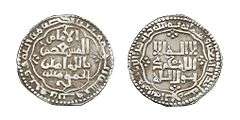Al-Musta'sim
| al-Musta'sim-Billah Abu-Ahmad Abdullah bin al-Mustansir-Billah المستعصم بالله أبو أحمد عبد الله بن المستنصر بالله | |
|---|---|
|
A dinar coined under Al-Musta'sim's rule. | |
| 37th Caliph of the Abbasid Caliphate Last Abbasid Caliph in Baghdad | |
| Reign |
5 December 1242 – 20 February 1258 (15 years 2 months 15 days) |
| Predecessor | al-Mustansir |
| Successor |
al-Mustansir as Abbasid Caliph in Cairo |
| Born | 1213 |
| Died | 20 February 1258 (aged 45) |
| Consort | Qurrat al-Ayn |
| Father | al-Mustansir |
| Religion | Sunni Islam |
Al-Musta'sim Billah (full name: al-Musta'sim-Billah Abu-Ahmad Abdullah bin al-Mustansir-Billah; Arabic: المستعصم بالله أبو أحمد عبد الله بن المستنصر بالله; 1213 – February 20, 1258) was the last Abbasid Caliph in Baghdad; he ruled from 1242 until his death.
Biography
Al-Musta'sim succeeded his father in late 1242.
He is noted for his opposition to the rise of Shajar al-Durr to the Egyptian throne during the Seventh Crusade. He sent a message from Baghdad to the Mamluks in Egypt that said: "If you do not have men there tell us so we can send you men."[1] However, Al-Musta'sim had to face the greatest menace against the caliphate since its establishment in 632: the invasion of the Mongol forces that, under Hulagu Khan, had already wiped out any resistance in Transoxiana and Khorasan. In 1255/1256 Hulagu forced the Abbasid to lend their forces for the campaign against Alamut.
In 1258, Hulagu invaded the Abbasid domain, which then consisted of only Baghdad, its immediate surroundings, and southern Iraq. In his campaign to conquer Baghdad, Hulagu Khan had several columns advance simultaneously on the city, and laid siege to it.
Baghdad was sacked on February 10 and the caliph was killed by Hulagu Khan soon afterwards. It is reckoned that the Mongols did not want to shed "royal blood", so they wrapped him in a rug and trampled him to death with their horses. Some of his sons were massacred as well; one of the surviving sons was sent as a prisoner to Mongolia, where Mongolian historians report he married and fathered children, but played no role in Islam thereafter.
The Travels of Marco Polo reports that upon finding the caliph's great stores of treasure which could have been spent on the defense of his realm, Hulagu Khan locked him in his treasure room without food or water, telling him "eat of thy treasure as much as thou wilt, since thou art so fond of it."[2]
Abbasid Caliph in Cairo
The Mamluk Sultans and Syria later appointed an Abbasid Caliph in Cairo, but they were even more symbolic than the by-now marginalized Abbasid Caliphs in Baghdad. Even though they kept the title for about 250 years more, other than installing the Sultan in ceremonies, these Caliphs had little importance. After the Ottomans conquered Egypt in 1517, the Abbasid Caliph of Egypt, Al-Mutawakkil III was transported to Constantinople, and Sultan Selim I announced himself to be a Caliph.
References
- ↑ Al-Maqrizi, p.464/vol1
- ↑ Yule-Cordier Edition
Sources
- Al-Maqrizi, Al Selouk Leme'refatt Dewall al-Melouk, Dar al-kotob, 1997.
| Al-Musta'sim Cadet branch of the Banu Hashim Born: 1213 Died: 20 February 1258 | ||
| Sunni Islam titles | ||
|---|---|---|
| Preceded by Al-Mustansir |
Caliph of Islam Abbasid Caliph 5 December 1242 – 20 February 1258 |
Vacant Title next held by Al-Mustansir |
